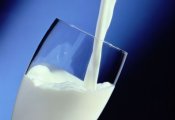Healthier milk with small changes in cow diet

Norwegian dairy and feed experts have succeeded in changing the fatty acid composition of milk by making small adjustments in the ration of the cows.
Tests on 43 dairy farms showed that the fatty acid composition of the milk changes. There is less saturated palmitic acid in milk, which is replaced by unsaturated fatty acids.
Approximately one quarter of all fat in regular milk is composed of palmitic acid. The assumption is that unsaturated fats are healthier for humans than saturated fatty acids.
The study was conducted by Norwegian dairy cooperative Tine, which processes 90% of all Norwegian milk.
The research was conducted by the University of Life Sciences in Ås. Results will be presented on today.
One of the preconditions for the research was that the altered feed composition should not lead to higher food prices. In Norwegian animal feed a lot of grain is processed, since that is mandatory.
Ration adjustment
The researchers do not want to reveal how the ration was changed. Dairy cooperative Tine this month intends to introduce a new product to the market that responds to the desire of consumers to reduce saturated fat in their food.
Change of fat composition by variation in feed is also applied in the Netherlands. Adaptation of the ration needs close monitoring, because overfeeding the cow with unsaturated fatty acids may have undesirable side effects, such as a decrease of fat content in the milk.
About 500 members of Friesland Campina give their animals a special ration to influence fatty acid composition in the milk.
Farmers have their cows eat as much fresh grass as possible, which by itself contains a high level of unsaturated fatty acids.
Friesland Campina claims that the milk products obtained from these cows’ milk contain 30% less saturated fat compared to comparable dairy products.











